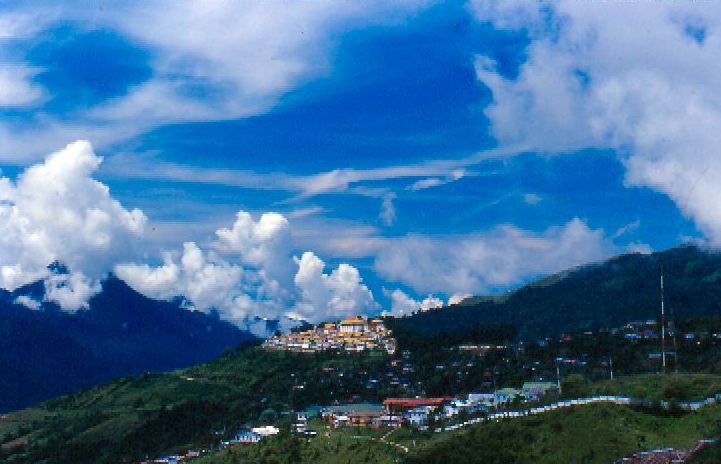|
Sangestar Tso
The Sangestar Tso, formerly called Shonga-tser Lake and popularly known as the Madhuri Lake, is located on the way from Tawang to Bum La Pass in Tawang district of Arunachal Pradesh, near Indo-China border above above sea level.Sangetsar Lake, a beautiful paradise near Tawang, named after Madhuri Dixit The Times of India, 29 January 2019.Sangestar Tso Government of Arunachal Pradesh, retrieved 10 July 2020. [...More Info...] [...Related Items...] OR: [Wikipedia] [Google] [Baidu] |
Tawang District
Tawang district (Pron:/tɑ:ˈwæŋ or təˈwæŋ/) is the smallest of the 26 administrative districts of Arunachal Pradesh state in northeastern India. With a population of 49,977, it is the eighth least populous district in the country (out of 707). History Tawang is inhabited by the Monpa people. From 500 BC to 600 AD a kingdom known as Lhomon or Monyul ruled the area. The Monyul kingdom was later absorbed into the control of neighbouring Bhutan and Tibet. Tawang Monastery was founded by the Merak Lama Lodre Gyatso in 1681 in accordance with the wishes of the 5th Dalai Lama, Ngawang Lobsang Gyatso, and has an interesting legend surrounding its name, which means "Chosen by Horse". The sixth Dalai Lama, Tsangyang Gyatso, was born in Tawang. Tawang was historically part of Tibet. The 1914 Simla Accord defined the McMahon Line as the new boundary between British India and Tibet. By this treaty, Tibet relinquished several hundred square miles of its territory, including Ta ... [...More Info...] [...Related Items...] OR: [Wikipedia] [Google] [Baidu] |
Arunachal Pradesh
Arunachal Pradesh (, ) is a state in Northeastern India. It was formed from the erstwhile North-East Frontier Agency (NEFA) region, and became a state on 20 February 1987. It borders the states of Assam and Nagaland to the south. It shares international borders with Bhutan in the west, Myanmar in the east, and a disputed border with China in the north at the McMahon Line. Itanagar is the state capital of Arunachal Pradesh. Arunachal Pradesh is the largest of the Seven Sister States of Northeast India by area. Arunachal Pradesh shares a 1,129 km border with China's Tibet Autonomous Region. As of the 2011 Census of India, Arunachal Pradesh has a population of 1,382,611 and an area of . It is an ethnically diverse state, with predominantly Monpa people in the west, Tani people in the centre, Mishmi and Tai people in the east, and Naga people in the southeast of the state. About 26 major tribes and 100 sub-tribes live in the state. The main tribes of the state are Adi, Nyshi ... [...More Info...] [...Related Items...] OR: [Wikipedia] [Google] [Baidu] |
Tawang
Tawang is a town and administrative headquarter of Tawang district in the Indian state of Arunachal Pradesh. The town was once the capital of the Tawang Tract, which is now divided into the Tawang district and the West Kameng district. Tawang continues as the headquarters of the former. Tawang is situated 448 km north-west of state capital Itanagar at an elevation of approximately . It lies to the north of the Tawang Chu river valley, roughly south of the Line of Actual Control with China. It is the site of a famous Gelugpa Buddhist Monastery. History Tawang is inhabited by the Monpa people. The Tawang Monastery was founded by the Merak Lama Lodre Gyatso in 1681 in accordance with the wishes of the 5th Dalai Lama, Ngawang Lobsang Gyatso, and has an interesting legend surrounding its name. ‘TA’ means 'Horse' and ‘WANG’ means 'Chosen'. So, the word 'Tawang' means "Chosen by Horse". As per a legend, the Monastery is believed to have been chosen by a Horse Owned by ... [...More Info...] [...Related Items...] OR: [Wikipedia] [Google] [Baidu] |
Bum La Pass
The Bum La Pass is a border pass between China's Tsona County in Tibet and India's Tawang district in Arunachal Pradesh. It is 37 km away from the town of Tawang in India's Tawang district and 43 km from the town of Tsona Dzong in China’s Tsona County. The pass currently serves as a trading point between Arunachal Pradesh and Tibet.Indo-China Border Trade Department of Trade & Commerce, Government of Arunachal Pradesh, retrieved 13 July 2020. It is also an agreed Border Personnel Meeting point for the security forces of China and India. Location An old traders road went from |
Nyamjang Chu
Nyamjang Chu, or Nyashang Chu () is a cross-border perennial river that originates in the Shannan Prefecture of Tibet and flows into the Arunachal Pradesh state of India, joining the Tawang Chu river just before it enters Bhutan. The Nyamjang Chu valley has provided the traditional communication route between Tawang and Tibet. The valley near town of Zemithang in the Tawang district, called the Pangchen Valley, is known for its serene beauty and forms one of the wintering locations for the black-necked crane. The China–India border in the valley has been contested between the two countries since the 1950s, resulting in a clash at Namka Chu in 1962 and a standoff at Sumdorong Chu in 1986. Course The Nyamjang Chu river originates in the snow-clad peaks of the eastern Himalayas, north of Taga in the Chudromo township of the Tsona County, at an elevation of . Frederick Bailey and Henry Morshead, explored the region in 1913. They crossed into the valley of Nyamjang Chu from ... [...More Info...] [...Related Items...] OR: [Wikipedia] [Google] [Baidu] |
Indian Army
The Indian Army is the land-based branch and the largest component of the Indian Armed Forces. The President of India is the Supreme Commander of the Indian Army, and its professional head is the Chief of Army Staff (COAS), who is a four-star general. Two officers have been conferred with the rank of field marshal, a five-star rank, which is a ceremonial position of great honour. The Indian Army was formed in 1895 alongside the long established presidency armies of the East India Company, which too were absorbed into it in 1903. The princely states had their own armies, which were merged into the national army after independence. The units and regiments of the Indian Army have diverse histories and have participated in several battles and campaigns around the world, earning many battle and theatre honours before and after Independence. The primary mission of the Indian Army is to ensure national security and national unity, to defend the nation from external aggression an ... [...More Info...] [...Related Items...] OR: [Wikipedia] [Google] [Baidu] |
Sports Utility Vehicle
A sport utility vehicle (SUV) is a car classification that combines elements of road-going passenger cars with features from off-road vehicles, such as raised ground clearance and four-wheel drive. There is no commonly agreed-upon definition of an SUV and usage of the term varies between countries. Thus, it is "a loose term that traditionally covers a broad range of vehicles with four-wheel drive." Some definitions claim that an SUV must be built on a light truck chassis; however, broader definitions consider any vehicle with off-road design features to be an SUV. A crossover SUV is often defined as an SUV built with a unibody construction (as with passenger cars), however, the designations are increasingly blurred because of the capabilities of the vehicles, the labelling by marketers, and electrification of new models. The predecessors to SUVs date back to military and low-volume models from the late 1930s, and the four-wheel drive station wagons and carryalls that began t ... [...More Info...] [...Related Items...] OR: [Wikipedia] [Google] [Baidu] |
Tawang District
Tawang district (Pron:/tɑ:ˈwæŋ or təˈwæŋ/) is the smallest of the 26 administrative districts of Arunachal Pradesh state in northeastern India. With a population of 49,977, it is the eighth least populous district in the country (out of 707). History Tawang is inhabited by the Monpa people. From 500 BC to 600 AD a kingdom known as Lhomon or Monyul ruled the area. The Monyul kingdom was later absorbed into the control of neighbouring Bhutan and Tibet. Tawang Monastery was founded by the Merak Lama Lodre Gyatso in 1681 in accordance with the wishes of the 5th Dalai Lama, Ngawang Lobsang Gyatso, and has an interesting legend surrounding its name, which means "Chosen by Horse". The sixth Dalai Lama, Tsangyang Gyatso, was born in Tawang. Tawang was historically part of Tibet. The 1914 Simla Accord defined the McMahon Line as the new boundary between British India and Tibet. By this treaty, Tibet relinquished several hundred square miles of its territory, including Ta ... [...More Info...] [...Related Items...] OR: [Wikipedia] [Google] [Baidu] |
Madhuri Dixit
Madhuri Dixit Nene (née Dixit; born 15 May 1967) is an Indian actress who primarily works in Hindi films. A leading actress of Indian cinema, she has appeared in over 70 films. Noted by critics for her beauty, dancing skills, and characters, Dixit was credited for singularly paralleling her male contemporaries and leading star vehicles in a male-dominated industry. She was among the country's highest-paid celebrities throughout the 1990s and early 2000s, and has featured in ''Forbes India'' Celebrity 100 list since its inception in 2012. Her accolades include six Filmfare Awards from a record 17 nominations. In 2008, the Government of India awarded her with Padma Shri, the fourth-highest civilian honour of the country. Born and raised in Mumbai, Dixit made her acting debut in 1984 with a leading role in the drama ''Abodh''. After a few successive commercially failed films, she rose to prominence with the action drama ''Tezaab'' (1988), and established herself with starring ro ... [...More Info...] [...Related Items...] OR: [Wikipedia] [Google] [Baidu] |
Bollywood
Hindi cinema, popularly known as Bollywood and formerly as Bombay cinema, refers to the film industry based in Mumbai, engaged in production of motion pictures in Hindi language. The popular term Bollywood, is a portmanteau of "Bombay" (former name of Mumbai) and " Hollywood". The industry is a part of the larger Indian cinema, which also includes South Cinema and other smaller film industries. In 2017, Indian cinema produced 1,986 feature films, of which the largest number, 364 have been from Hindi. , Hindi cinema represented 43 percent of Indian net box-office revenue; Tamil and Telugu cinema represented 36 percent, and the remaining regional cinema constituted 21 percent. Hindi cinema has overtaken the U.S. film industry to become the largest centre for film production in the world. In 2001 ticket sales, Indian cinema (including Hindi films) reportedly sold an estimated 3.6 billion tickets worldwide, compared to Hollywood's 2.6 billion tickets sold. Earlier Hindi film ... [...More Info...] [...Related Items...] OR: [Wikipedia] [Google] [Baidu] |
Koyla
''Koyla'' ( Coal) is a 1997 Indian Hindi-language action thriller film directed, co-written and produced by Rakesh Roshan, which stars Shah Rukh Khan, Madhuri Dixit and Amrish Puri in lead roles, while Johnny Lever, Ashok Saraf, Salim Ghouse, Deepshikha and Himani Shivpuri appear in supporting roles. Mohnish Bahl makes a special appearance in the film. The film was released worldwide on 18 April 1997 and was declared an average grosser at the box office, earning over 28.05 crore worldwide against a budget of 11.90 crore. Critics praised the action sequences performed by Khan, and it emerged as the 8th most successful film of 1997 in India. Some scenes of the film were shot in Tawang, Arunachal Pradesh. This is the third and final collaboration between Shah Rukh Khan and Rakesh Roshan, due to Rakesh's son Hrithik Roshan entering films and replacing Shah Rukh Khan in Rakesh's films. The film earned Puri a Best Villain at the 43rd Filmfare Awards. Plot Handsome but mute, Shankar ... [...More Info...] [...Related Items...] OR: [Wikipedia] [Google] [Baidu] |


.jpg)






